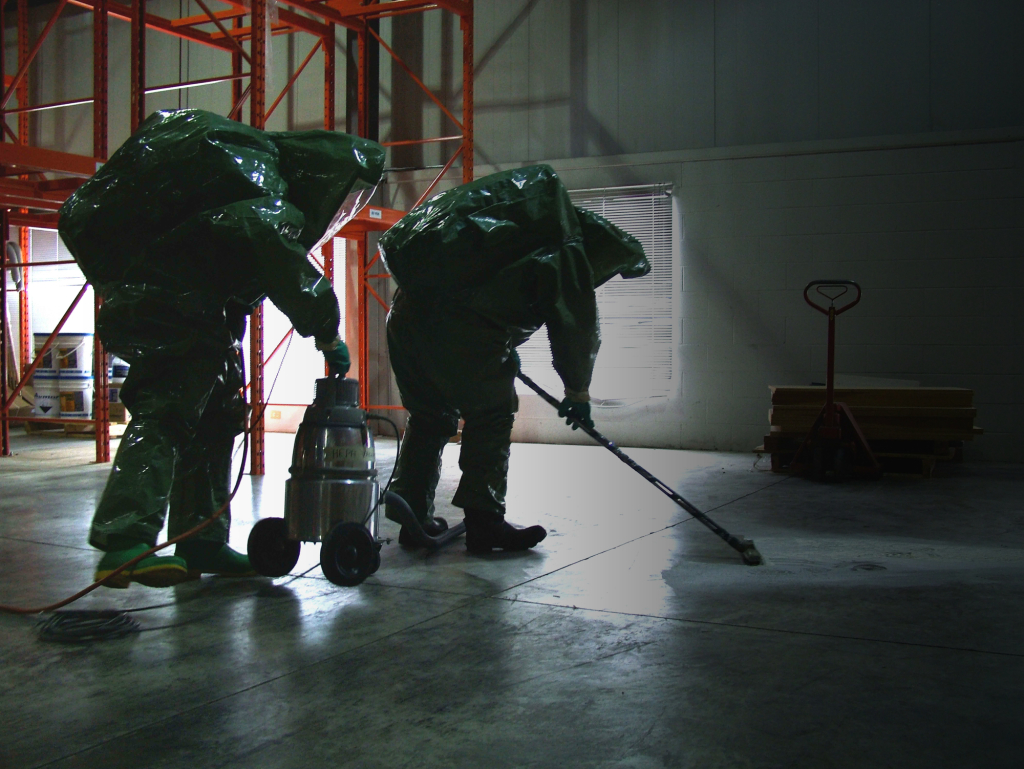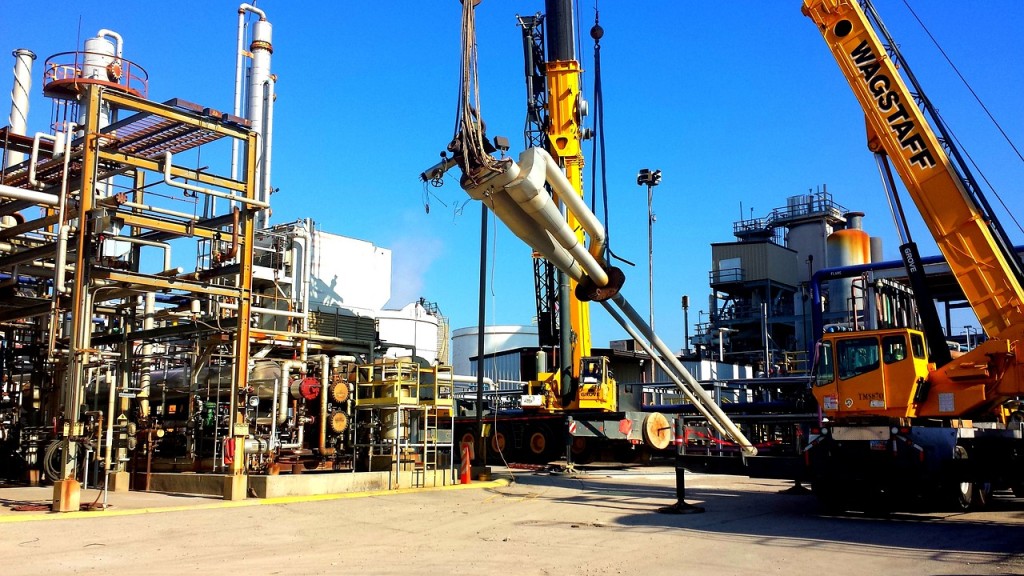Spill response training caters to a diverse audience, including employers, supervisors, general workers, members of workplace spill response or emergency response teams, participants in Joint Health and Safety Committees, and Environmental Managers.
However, the training is accessible to any worker seeking to acquire knowledge about the safe and practical measures involved in spill response. Participants also have the opportunity to enhance their comprehension of their responsibilities under the Ontario Environmental Protection Act.
In this article, we will examine what workplaces require spill response training, the risks associated with handling spills without the proper training, and what spill response training involves.
Click on each corresponding link to jump ahead:
- What Workplaces Require Spill Response Training?
- Handling Spills Without Spill Response Training
- What Does Spill Response Training Involve?
ACUTE Environmental is your go-to resource for all things safety training. Simply contact us today to set up your spill response training!
Spill Response Training – Everything You Need to Know

If you work in an industrial facility or a laboratory, you may need spill response training.
1. What Workplaces Require Spill Response Training?
Spill response training is essential in various workplaces where the potential for spills exists. The nature of the spills can vary, including:
- Liquids
- Chemicals
- Hazardous materials
Some workplaces where spill response training might be necessary include:
A) Industrial Facilities
Manufacturing plants, chemical processing plants, and other industrial settings often handle and store chemicals, oils, and other hazardous materials that can lead to spills.
Example: In a chemical manufacturing plant, a tank containing a corrosive chemical begins leaking due to a faulty valve. Without spill response training, workers may not know how to safely contain the leak, leading to the spread of the corrosive substance. Proper training ensures that employees can quickly identify the source of the leak, use appropriate containment measures, and initiate cleanup procedures to prevent environmental contamination and protect personnel.
B) Laboratories

Laboratory workers handle various chemicals – Image by Michal Jarmoluk from Pixabay
Research laboratories deal with various chemicals, some of which can be hazardous. Training in spill response is crucial to ensure the safe handling and containment of these substances.
Example: In a research laboratory, a scientist accidentally spills a concentrated acid while transferring it between containers. Spill response training is crucial in this scenario to guide the scientist on immediately neutralizing the spilled acid, wearing protective gear, and properly cleaning the affected area. This prevents injuries, chemical exposure, and contamination within the laboratory environment.
C) Hospitals and Healthcare Facilities
Medical facilities use a variety of substances, including cleaning agents, pharmaceuticals, and biohazardous materials, which may pose spill risks.
Example: In a hospital, a nurse accidentally spills a chemotherapy drug while preparing medication for a patient. Spill response training becomes essential for the nurse to quickly contain the spill, follow proper decontamination procedures, and ensure the safety of both the healthcare provider and the patients receiving treatment. This prevents the spread of hazardous substances within the healthcare setting.
D) Waste Treatment and Disposal Facilities
Facilities dealing with the treatment and disposal of hazardous waste must be prepared for spills that can occur during these processes.
Example: At a hazardous waste disposal facility, a container holding toxic chemicals is accidentally punctured during handling. Spill response training is crucial for facility workers to quickly isolate the affected area, use appropriate absorbents and barriers, and properly dispose of the contaminated materials. This prevents the release of hazardous substances into the environment and safeguards the health of workers.
E) Oil and Gas Industry

Oil leaks are a serious concern – Image by John R Perry from Pixabay
Operations related to the exploration, extraction, and transportation of oil and gas involve handling large quantities of potentially hazardous substances.
Example: On an offshore oil rig, a pipeline develops a leak, releasing crude oil into the surrounding waters. Spill response training is critical for the rig personnel to swiftly activate emergency response plans, deploy containment booms, and initiate cleanup operations. Proper training minimizes the environmental impact of the oil spill, protects marine life, and ensures the safety of the workers involved in response efforts.
F) Agricultural Settings
Farms and agricultural facilities may use fertilizers, pesticides, and other chemicals that could result in spills.
Example: On a farm, a spill occurs when a pesticide applicator overturns, leading to the leakage of agricultural chemicals. Spill response training is essential for farmworkers to quickly establish a perimeter around the spill, use appropriate absorbents, and prevent the chemicals from reaching water sources or affecting nearby crops. Proper training minimizes environmental contamination and protects the health of workers and the surrounding ecosystem.
Employers need to assess the specific risks in their workplace and provide appropriate training to employees to respond effectively to spills. Overall, spill response training is critical for preventing injuries, minimizing environmental damage, and ensuring a coordinated and effective response to spills in diverse industrial settings.
2. Handling Spills Without Spill Response Training
Handling spills without proper training in spill response poses significant risks, including:
A) Personal Injury

Absorbents are great for cleaning up hazardous spills.
Untrained individuals may not be aware of the potential hazards associated with spilled substances. This lack of awareness increases the risk of personal injury through direct contact, inhalation, or absorption of hazardous materials. To learn how to properly handle hazardous materials, proper safety training is required.
B) Exposure to Toxic Substances
Without knowledge of the spilled substance and appropriate handling procedures, individuals may inadvertently expose themselves to toxic chemicals. This exposure can lead to acute or chronic health issues, depending on the nature of the substance.
C) Spread of Contamination
Inadequate spill response can result in the uncontrolled spread of contaminants. This can affect a larger area, increasing the environmental impact and making cleanup more challenging and costly.
D) Environmental Damage

Oil spills and extremely harmful to the environment – Image by C Morrison from Pixabay
Spills that are not properly contained and cleaned up can have severe environmental consequences. Contaminants may enter:
- The soil
- Water bodies
- The air
In return, this harms ecosystems, wildlife, and vegetation.
E) Delayed Response
Untrained personnel may hesitate or take longer to respond to a spill. Delays in containment and cleanup efforts can exacerbate the consequences of the spill and increase the overall risk of harm.
F) Ineffective Cleanup
Without proper training, individuals may use incorrect or ineffective cleanup methods. Incomplete or inadequate cleanup can leave residual contamination, posing long-term risks to both the environment and human health.
G) Fire and Explosion Hazards

Be careful around spilled chemicals, chances are they are flammable – Image by Bernd Rehbein from Pixabay
Some spilled substances may be flammable or reactive, posing fire or explosion risks. Untrained individuals may inadvertently introduce ignition sources or fail to take appropriate precautions, leading to catastrophic incidents.
H) Regulatory Non-Compliance
Failure to handle spills per regulatory requirements can lead to legal consequences. Fines, penalties, and legal actions may be imposed on organizations or individuals who do not comply with environmental and safety regulations.
Overall, the risks associated with handling spills without proper training are multifaceted and can have serious consequences for
- Individuals
- The environment
- Regulatory compliance
Spill response training is essential to mitigate these risks, protect human health, and minimize the environmental impact of spills.
3. What Does Spill Response Training Involve?
Spill response training covers the legislative requirements and measures for spill reporting and cleanup. Participants are taught practical strategies to both prevent and safely contain spills that occur in the workplace. These training programs are also routinely customized to reflect clients’ sites and products.
Training program topics include:
- Spill law and regulations: Ontario Environmental Protection Act
- Defining a reportable spill and reporting requirements
- Creating a safe spill response plan
- Recognize hazards
- Assessing Risk
- Controlling Risk
- Personal Protective Equipment selection
- Evaluating Controls
- Sorbents and cleanup materials
- Containment materials and strategies
- 8 safe and practical steps for spill response
- How to properly dispose of spent spilled materials
Register for spill response training today.
Need Spill Response Training? Rely on ACUTE Environmental

ACUTE can transform your workplace to be more safety compliant.
If you are in charge of supervising health and safety in the workplace or you are concerned that your workplace is not safety complaint, or you need spill response training, book a course with ACUTE. Here are some of the benefits of working with ACUTE:
- Open Door Instructor-Student Partnership – ACUTE’s training services emphasize client participation, staff foster relationships with clients and serve as a touchstone for advice anytime moving forward.
- Serving Your Team and Industry – With a vast array of clients in manufacturing, construction, health, academic, and government sectors, ACUTE brings the best safety practices from across the spectrum to your workplace.
- 100 Years Combined Experience – ACUTE provides comprehensive health and safety training, on-site safety services, and consulting services. With over 100 years of combined experience, our company staff offers more than theoretical or abstract ideas. ACUTE offers solutions!
- Track Record of Success – ACUTE is rated 4.9/5 stars on Google reviews, demonstrating our commitment to our clients, our quality, and our passion for training.
It is one thing to understand what HSE is and another to know how to conduct an HSE presentation. Contact Acute Environmental today to learn more about health, safety, and the environment.
What Our Customers Are Saying…
We were referred to ACUTE on behalf of our employer for an n95 mask fitting – the staff here are professional, personable, and informative.
I’d come back here for any safety-related training in a heartbeat.
Acute has been a staple in supporting my companies over the years and have always delivered quality and dependable service. Training programs are top shelf and a great facility for practical application. couldn’t recommend them more. keep up the great work folks.
Outstanding service provided by Acute, right from the customer support end, right through to the delivery of the session. Always professional, quick to respond, and always delivering services that exceed my expectations. Acute has an amazing team that is always helping us achieve better health and safety performance. So are grateful to have such a tremendous resource in Acute!
Hours of Operation and Contact Information:
Monday-Friday: 8:00 AM – 5:00 PM
Saturday-Sunday: Closed
Phone: (519) 747-5075
Fax: (519) 747-4608
Email: info@acuteservices.com

